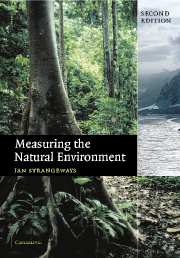Book contents
- Frontmatter
- Contents
- Acknowledgements
- 1 Basics
- 2 Radiation
- 3 Temperature
- 4 Humidity
- 5 Wind
- 6 Barometric pressure
- 7 Evaporation
- 8 Precipitation
- 9 Soil moisture and groundwater
- 10 Rivers and lakes
- 11 Data logging
- 12 Telemetry
- 13 Visibility
- 14 Clouds
- 15 Lightning
- 16 The upper atmosphere
- 17 The oceans
- 18 Cold regions
- 19 Remote sensing
- 20 Atmospheric composition
- 21 Forward look
- Appendix: abbreviations and acronyms
- Index
- References
17 - The oceans
Published online by Cambridge University Press: 05 July 2014
- Frontmatter
- Contents
- Acknowledgements
- 1 Basics
- 2 Radiation
- 3 Temperature
- 4 Humidity
- 5 Wind
- 6 Barometric pressure
- 7 Evaporation
- 8 Precipitation
- 9 Soil moisture and groundwater
- 10 Rivers and lakes
- 11 Data logging
- 12 Telemetry
- 13 Visibility
- 14 Clouds
- 15 Lightning
- 16 The upper atmosphere
- 17 The oceans
- 18 Cold regions
- 19 Remote sensing
- 20 Atmospheric composition
- 21 Forward look
- Appendix: abbreviations and acronyms
- Index
- References
Summary
Nobody — not even Captain MacWhirr, who alone on deck had caught sight of a white line of foam coming on at such a height that he couldn't believe his eyes — nobody was to know the steepness of that sea and the awful depth of the hollow the hurricane had scooped out behind the running wall of water.
Joseph Conrad Typhoon.The oceans: a history of their measurement
The entire heat capacity of the Earth's atmosphere is equivalent to about the top 3 m of the ocean's water (Houghton 1997). And below these 3 m lies another 2000—5000 m, with trenches down to 11000 m, with an average depth of 2000 m. In addition to their great depth and thermal mass, the oceans also cover 71% of the Earth's surface. A glance at a globe demonstrates that the Pacific Ocean alone covers almost half of the planet, and, viewed from the south, the 81% ocean-cover of the southern hemisphere is clearly evident. Given this dominance by the seas, it seems a reasonable expectation that the weather, and changes in climate, may well be driven as much, if not more, by the oceans than by the atmosphere and the continents. At the very least we should pay as much attention to measuring the weather above the oceans and the conditions down into their depths as we have done to measuring that over the land and up into the atmosphere.
- Type
- Chapter
- Information
- Measuring the Natural Environment , pp. 421 - 451Publisher: Cambridge University PressPrint publication year: 2003



